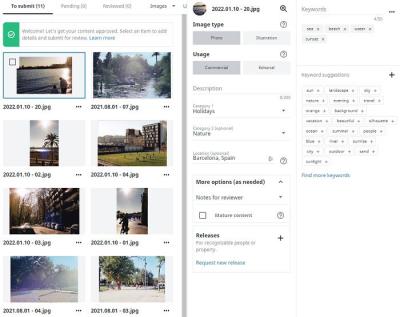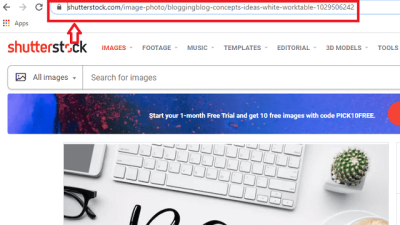Looking to spice up your projects with stunning visuals? Shutterstock is a go-to platform for designers, marketers, and content creators alike. It offers a vast library of high-quality images, vectors, illustrations, and videos that can elevate your work to the next level. Whether you’re creating social media graphics, website banners, or print materials, Shutterstock has the resources you need. The best part? It’s user-friendly and packed with tools to help you find exactly what you’re looking for quickly. Let’s dive into how you can make the most of
Steps to Access and Search for Graphics on Shutterstock
Getting started with Shutterstock is simple and straightforward. Here’s a step-by-step guide to help you access and find the perfect graphics for your project:
- Sign Up or Log In: First, visit the Shutterstock website. If you don’t have an account, signing up is quick and free—just click on the “Sign Up” button and follow the prompts. Already a member? Log in with your credentials.
- Navigate to the Search Bar: Once logged in, you’ll see a prominent search bar at the top of the homepage. This is your gateway to the entire library of resources.
- Enter Your Search Terms: Type in keywords related to the graphics you’re looking for. Be specific to get better results—for example, instead of “flower,” try “watercolor flower illustration.”
- Use Filters to Narrow Down Results: After hitting search, you’ll notice filters on the results page. You can filter by:
- Media Type: Photos, vectors, illustrations, videos
- Orientation: Landscape, portrait, square
- Color: Single color, color schemes
- License Type: Royalty-free or rights-managed
- New Arrivals: Most recent additions
- Preview and Select: Click on any thumbnail to preview the graphic in full size. If you like it, you can add it to your download cart or save it to a collection for later.
- Download or License: Once you’ve made your choice, follow the prompts to purchase or license the graphic. Remember, licensing terms vary, so always choose the right options for your project’s needs.
By following these steps, you’ll quickly become comfortable navigating Shutterstock and finding the perfect visuals to bring your creative ideas to life. Happy searching!
Tips for Selecting the Right Graphics for Your Projects
Choosing the perfect graphics for your project can sometimes feel overwhelming, especially with the vast library Shutterstock offers. But don’t worry—there are a few handy tips to help streamline your selection process and ensure you pick visuals that truly enhance your content.
First things first, define your project’s purpose and audience. Are you creating a professional business presentation, a fun social media post, or an educational infographic? Knowing your goal helps you narrow down the style, tone, and type of graphics that will resonate most. For example, sleek, minimalistic icons work well for corporate projects, while colorful illustrations might be better suited for kids’ content.
Next, consider the relevance and message of the graphic. Ask yourself, “Does this image communicate what I want it to?” Sometimes a visually appealing graphic might look great but may not align with your message. Make sure it supports the story you’re telling or the point you’re making.
Another tip is to pay attention to the licensing details. Shutterstock offers different licensing options—standard and enhanced. For most web or social media uses, standard licenses are sufficient, but for print or commercial campaigns, you might need an enhanced license. Always double-check to avoid any legal hiccups later on.
Also, think about the visual style and color scheme of your project. Consistency is key. If your brand uses specific colors or a particular aesthetic, look for graphics that complement or match that style. Shutterstock’s filtering tools can help you narrow down options by color, type, or style, making your search more efficient.
Lastly, don’t be afraid to explore different types of graphics—photos, vectors, illustrations, icons. Mixing and matching can create a more engaging and dynamic visual experience. Take your time browsing, and don’t settle on the first thing you see. Remember, the right graphic can make all the difference in how your message is received!
How to Customize Shutterstock Graphics for Your Needs
Once you’ve selected the perfect graphic, the next step is customizing it to fit your specific project. Shutterstock provides a variety of ways to tweak and personalize visuals, making them truly yours. Here’s how you can do it effectively:
Use editing software: Most Shutterstock graphics come in formats compatible with popular editing tools like Adobe Photoshop, Illustrator, or even free options like Canva or GIMP. These tools allow you to change colors, resize elements, add text, or combine multiple graphics seamlessly.
Change colors to match your brand: One of the easiest ways to personalize a graphic is by adjusting its color palette. For vectors and illustrations, you can often change fill colors or stroke colors to align with your branding. This creates a cohesive look across your project.
Add your own text or branding elements: Incorporate your logo, tagline, or custom messaging directly onto the graphic. Most editing tools let you overlay text with various fonts and styles, helping you craft a more branded and professional appearance.
Resize and crop: Adjust the size of the graphic to fit your layout without losing quality. Cropping can also help focus attention on a specific part of the image or make it more suitable for social media posts or banners.
Combine graphics: Don’t hesitate to layer multiple Shutterstock images or illustrations to create a unique composite. This can add depth and interest to your visuals, making them stand out.
For those less familiar with editing software, Shutterstock also offers integrations with some online design tools like Canva, where you can easily customize graphics with drag-and-drop features. Remember, the goal is to make the graphic align perfectly with your project’s tone and style, so don’t be afraid to experiment and tweak until it feels just right.
By customizing Shutterstock graphics thoughtfully, you ensure your visuals are not only eye-catching but also perfectly tailored to communicate your message effectively. Happy designing!
Best Practices for Downloading and Using Shutterstock Graphics
When it comes to making the most out of Shutterstock, it’s all about being smart and respectful with how you download and utilize their graphics. First things first, always double-check the license type for each image or graphic. Shutterstock offers various licenses, so understanding whether you’re using a standard or enhanced license helps you stay compliant and avoid any legal hiccups down the line.
Once you’ve selected the perfect graphic, avoid rushing the download process. Make sure your internet connection is stable, and choose the appropriate resolution—higher resolutions are ideal if you plan to print or use the graphic in large formats. Remember, downloading a low-res version for preview is fine, but for actual use, always opt for the full-quality image.
Here are some tips to keep in mind:
- Use relevant keywords: When searching, be specific with your keywords to find exactly what you need quickly.
- Organize your downloads: Create folders or collections within Shutterstock to keep your graphics organized by project or theme.
- Avoid overusing the same graphic: If you plan to use a graphic multiple times across different projects, consider licensing it accordingly or purchasing extended rights.
- Respect attribution requirements: Most Shutterstock images don’t require attribution, but always double-check the license details.
- Be mindful of edits: Feel free to crop, resize, or modify graphics to better fit your design, but avoid altering images in a way that misrepresents the original or infringes on rights.
Lastly, always keep a record of your licenses and downloads. This helps if you need to verify usage rights later or if you’re working with clients who require proof of licensing. By following these best practices, you’ll ensure that your use of Shutterstock graphics remains seamless and compliant, letting you focus on creating stunning visuals without unnecessary stress.
Integrating Shutterstock Graphics into Your Design Workflow
Integrating Shutterstock graphics into your design workflow can be a game-changer, saving you time and elevating your projects. The key is to create a smooth process that allows you to access, edit, and deploy images efficiently. Here’s how to do it:
Step 1: Establish a Centralized System
Start by setting up a dedicated folder or digital library for all your Shutterstock downloads. This way, you can quickly locate assets when needed, rather than wasting time searching through scattered files.
Step 2: Use Compatible Design Software
Most Shutterstock graphics are compatible with popular design tools like Adobe Photoshop, Illustrator, Canva, or Figma. Make sure your software supports the formats you download, such as JPEG, PNG, or vector files (AI, EPS). This compatibility allows you to seamlessly incorporate assets into your projects.
Step 3: Customize Graphics to Fit Your Style
Once imported into your design software, don’t hesitate to customize Shutterstock assets. Adjust colors, resize, crop, or combine graphics to match your brand style and project needs. Remember, the goal is to make the graphics work harmoniously within your overall design.
Step 4: Maintain Consistency
Consistency is vital in branding and design. Create templates or style guides that incorporate Shutterstock graphics. This ensures uniformity across your materials, whether it’s social media posts, marketing collateral, or website visuals.
Step 5: Automate and Streamline
If you frequently use Shutterstock graphics, consider automating parts of your workflow. Use plugins or integrations (like Shutterstock’s plugin for Adobe Creative Cloud) to streamline inserting images directly into your projects. Also, develop a checklist or standard operating procedure for licensing, editing, and deploying assets.
Step 6: Collaborate Effectively
Share your organized Shutterstock assets with team members or clients using cloud storage or project management tools. This promotes collaboration and ensures everyone has access to the latest visuals, minimizing miscommunication or redundant work.
By embedding Shutterstock graphics thoughtfully into your workflow, you’ll not only speed up your project timelines but also produce more polished, cohesive visuals. Remember, the goal is to make your assets work for you—efficiently and creatively—so you can focus on what you do best: crafting compelling, beautiful designs.
Conclusion and Additional Resources for Graphic Creation
In today’s digital landscape, leveraging platforms like Shutterstock can significantly enhance your graphic creation process. By utilizing high-quality images, vectors, and customizable templates, you can produce professional visuals efficiently. Remember to always adhere to licensing agreements to avoid copyright issues and respect intellectual property rights. Incorporate various design elements such as bold text, lists, and tables to make your graphics more engaging and organized. Practice experimenting with different styles and tools available on Shutterstock to find what best suits your project needs.
For further improvement, explore the following resources:
- Shutterstock Tutorials: Official guides and how-to videos to master platform features.
- Design Blogs: Websites like Canva Design School and Adobe Creative Cloud Blog offer valuable tips and inspiration.
- Online Courses: Platforms such as Udemy or Skillshare provide courses on graphic design fundamentals and advanced techniques.
- Community Forums: Engage with communities on Reddit or Graphic Design Stack Exchange to seek advice and share ideas.
By combining these resources with your creative efforts, you can maximize the potential of Shutterstock for producing compelling and effective graphics. Continuous learning and experimentation are key to refining your skills and staying ahead in the ever-evolving world of visual content creation.


